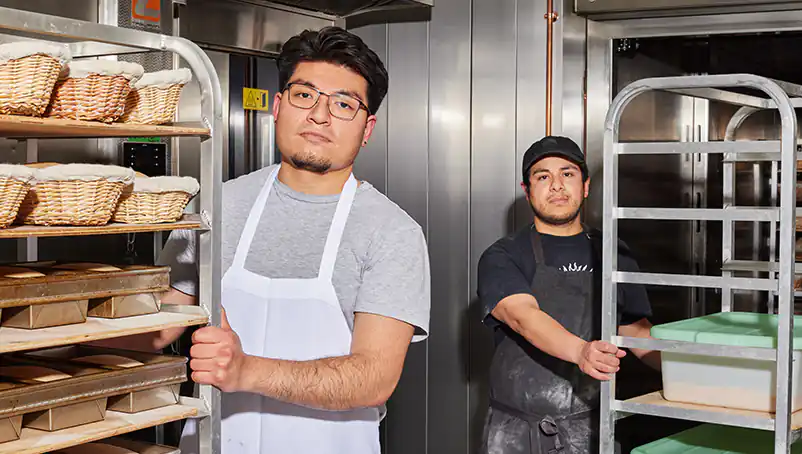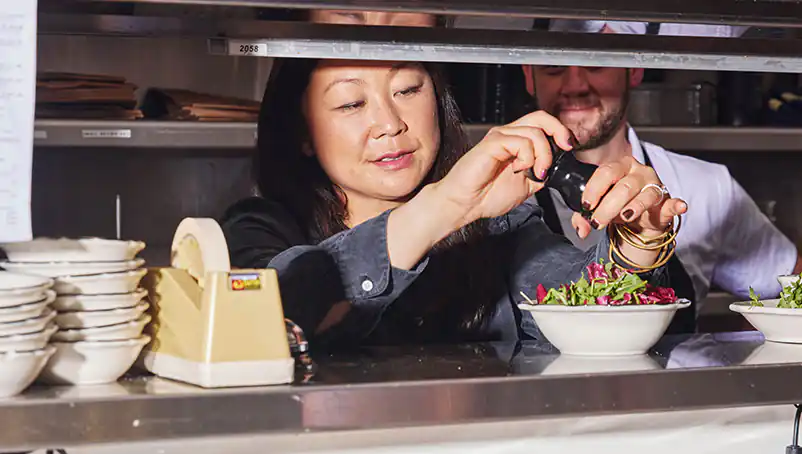When running a restaurant, it sometimes feels like everyone’s cleaning almost as much as cooking, right? Keeping a commercial kitchen clean takes work, but it's necessary if you want to prevent injuries and illness and pass your health inspections.
The good news is that with a bit of elbow grease and the right cleaning products, you can keep your kitchen sparkling like (almost) new. But it helps to have systems in place keeping track of what gets cleaned and when so you don’t miss anything.
In this article, we’ll look at:
- Top kitchen hazards and ways you can minimize them
- How restaurant cleaning services can help keep your kitchen clean
- Restaurant cleaning checklist
Top commercial kitchen hazards
When you operate a commercial kitchen, some things pose more risk than home kitchens since you’re working with professional-grade equipment, more people and larger food quantities.
Here are some of the top hazards you’ll encounter and how keeping your kitchen clean can help you avoid insurance claims and minimize potential damage.
1. Floor contamination
Falls, slips and trips are the second leading cause of injury in the full-service restaurant industry. You can help prevent injuries by wiping up spills as soon as they happen to keep floors dry and giving them a more thorough cleaning at the end of every day.
2. Fires
More than 7,400 fires occur in restaurants each year, and cooking equipment is responsible for 61% of them. Disaster can strike when you combine grease build-up and improperly stored materials with an open flame.
Properly cleaning the kitchen to reduce grease build-up and disposing of oily rags and other flammable materials is essential for fire prevention.
3. Food contamination
Did you know almost half of foodborne illness in the United States occurs in restaurants? Contamination can occur when food prep surfaces and utensils aren't properly sanitized and employees aren't following proper hygiene practices.
To reduce the risk of foodborne illness in your kitchen, make sure you thoroughly clean surfaces that come in contact with food and employees wash their hands before and after handling food.
How restaurant cleaning services can help keep your commercial kitchen clean
You could train your employees on all aspects of cleaning your commercial kitchen and handle the job in-house. But they already have a lot on their plates.
Getting some outside help can help lighten their load and yours too. Plus, some jobs are better left to the professionals.
What restaurant cleaning services do
Commercial restaurant cleaning companies can provide a variety of services, including:
- Light cleaning. Professional cleaning services can help with the day-to-day responsibilities such as dusting, vacuuming, cleaning the bathrooms, wiping down tables and chairs, emptying the trash, etc.
- Kitchen cleaning. Some companies specialize in kitchen cleaning and will deep clean appliances, floors, walls, ceilings and more.
- Specialty services. Some companies specialize in certain aspects of kitchen cleaning, such as hoods, vents and exhaust systems.
How often should you hire a professional restaurant cleaner?
The answer depends on your budget and how much time you want your staff to dedicate to cleaning.
At a minimum, it makes sense to hire professional cleaners to do a deep clean of your kitchen a couple of times a year if you choose not to get professional help regularly.
How much does a cleaning service cost?
It depends. In general, costs range from $50 to $150 an hour, but the price you’ll pay varies based on multiple factors, including your location and what you want cleaned.
You'll usually pay less for light cleaning duties such as dusting and vacuuming and more for deeper cleaning. Commercial kitchen cleaning typically costs $100 or more an hour.
Restaurant cleaning checklist
If you want to keep your commercial kitchen operating like a well-oiled machine, it needs to be cleaned regularly.
You can track the completion of weekly and monthly tasks on paper or in a spreadsheet, but if you use digital tools, you can set up reminders to get things done.
Here's a checklist to help you track what you need to clean and when so you don't miss anything.
Daily
- Spills. Clean them up as soon as they happen.
- Food prep surfaces. Sanitize counters, cutting boards and other items used to prepare food multiple times a day.
- Appliances. Wipe down appliances such as toasters, coffee makers and the outside of the refrigerator. Do a deeper clean weekly or monthly.
- Deep fat fryer. Wipe down the exterior.
- Flat grills and griddles. Use a brush to remove debris and grease after every use.
- Oily rags. Oily rags are a fire hazard. Store them properly.
- Floors. Sweep and mop the floor in the kitchen, dry storage area, and walk-in freezer.
- Sinks. Food particles can build up in sinks. Clean them at the end of each day.
Weekly
- Boil out the deep fryer. Remove the oil. Use a brush to remove debris from the interior and clean it out. Rinse it, and fill it with water and fryer cleaner. Boil the water for about 20 minutes. Then drain the fryer, rinse it and clean out any grease or food build-up.
- Sinks. Delime each week.
- Clean the floor drain. You can use soapy water and a snake to take care of minor clogs yourself, but more severe obstructions might require professional help.
- Walls and ceiling. Grease can accumulate on the walls and ceiling. Scrub them once a month to remove grease and other stains.
- Oven. Remove the racks from inside the oven and soak them while you're cleaning the interior. Clean out food, crumbs and other debris first. Then use a non-toxic cleaning solution to wash the interior. Be sure to follow the manufacturer's instructions when cleaning the oven.
Monthly
- Appliances. Deep clean monthly.
- Refrigerator coil. Vacuum and clean the refrigerator coil to keep the unit running properly.
- Freezers, ice machine and dry storage. Deep clean each month.
- Drains and pipes. Grease can build up in sink drains and pipes. Clean them with a degreasing product made for drains and safe for plumbing.
- Grease traps. Empty when they become ¼ full, which usually takes about one to three months.
- Hoods and vents. The hood and ventilation system help push heat outside. The frequency you need to clean these elements varies based on the type of fuel you use and your cooking volume. For restaurants, it typically ranges from monthly to semi-annually. Don’t forget about the filters. You need to clean those too, and you should replace them if they are damaged. Due to the complexity of the job and how important it is in preventing fire, it’s often a good idea to hire a professional.
How NEXT can help protect your business
Even when you take proper precautions, accidents can happen in the kitchen. NEXT provides customized food and beverage insurance solutions to restaurants and other food service establishments to help protect your business.
Complete our online application to see coverage options, get a quote and purchase insurance – all in less than 10 minutes. Get access to your certificate of insurance as soon as you make a payment.
If you have questions or need help at any time, our licensed, U.S.-based insurance professionals are available to help.
Get started with your free quote today.





